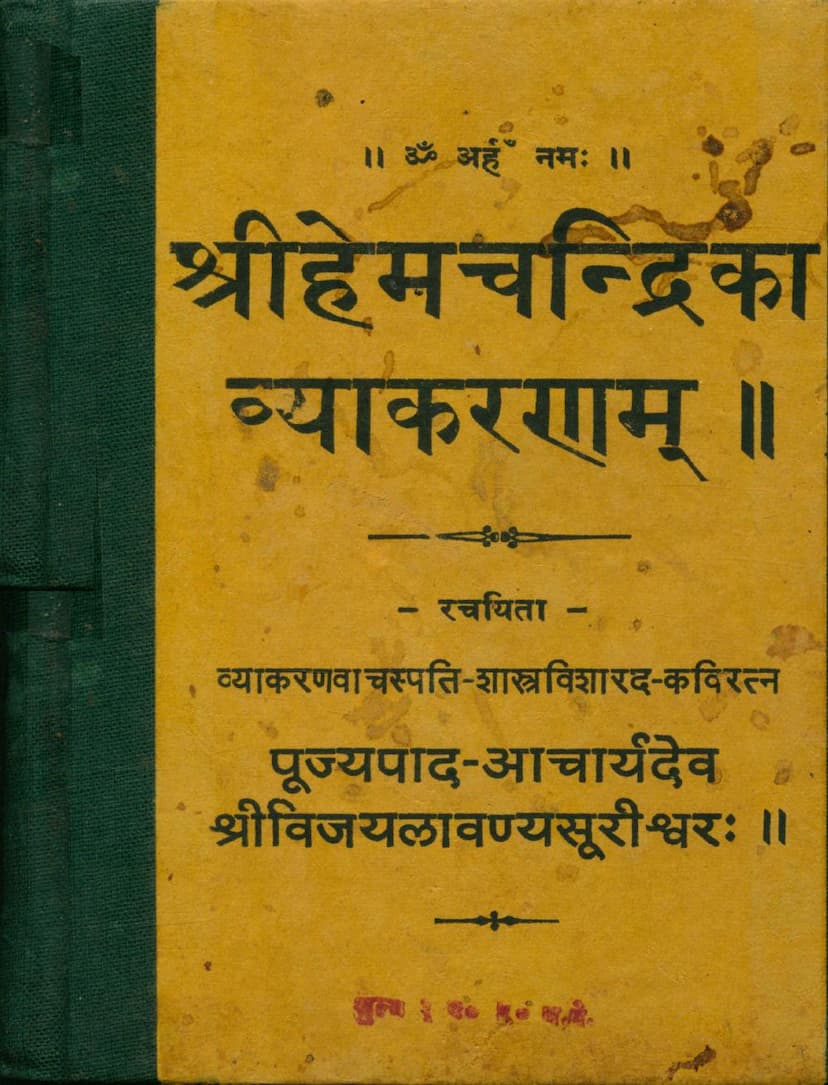Hemchandrika Vyakaranam
Added to library: September 1, 2025

Summary
This is a comprehensive summary of the Jain text "Hemchandrika Vyakaranam" by Vijaylavanyasuri, based on the provided pages and catalog link.
Book Title: Hemchandrika Vyakaranam Author: Vijaylavanyasuri (also referred to as Acharya Shri Vijaylavanyasurishwar) Publisher: Gyanopasak Samiti Catalog Link: https://jainqq.org/explore/023427/1
Overview:
"Hemchandrika Vyakaranam" is a grammar text, presented as the 58th jewel in the Shri Vijaynemisurishwar Granthamala. It is a simplified and comprehensive grammar based on the renowned "Shri Siddha-Hema-Shabd-Anushasan" by Acharya Shri Hemchandracharya. The text aims to make the study of Sanskrit grammar accessible and enjoyable for students, particularly young learners, by presenting complex grammatical concepts in a clear and concise manner.
Key Features and Content:
-
Author and Patronage: The book is authored by the esteemed Acharya Shri Vijaylavanyasurishwar, who is highly praised for his vast knowledge and literary contributions. The publication is attributed to the Shri Gyanopasak Samiti and supported by the generous contribution of Hemraj Hansraj Bhandari and his family from Varada, Rajasthan. The book is dedicated to the lineage of spiritual leaders, specifically mentioning Jagadguru Tapogachhesh Shri Vijaynemisurishwarji.
-
Purpose and Philosophy: The introductory pages emphasize the paramount importance of grammar ("Vyakaranam") as the "lamp of all knowledge" ("Pradipah Sarva Vidyanaam"). It states that grammatical knowledge is essential for understanding the meaning of words, leading to the understanding of truth, and ultimately, to liberation (Moksha). The text highlights the foundational role of Sanskrit and Prakrit languages in preserving Indian culture and civilization.
-
Structure and Content: The book is divided into two main parts: "Purvardha" (पूर्वाध) and "Uttarardha" (उत्तरार्ध).
-
Purvardha (First Part): This section covers the foundational aspects of Sanskrit grammar. It includes chapters on:
- Samjna Prakaranam (संज्ञाप्रकरणम्): Deals with basic grammatical definitions, including vowels (swaras), consonants (vyanjanani), their classification, and phonetic principles.
- Sandhi Prakaranam (सन्धिप्रकरणम्): Explains the rules of phonetic combination (sandhi). This is further broken down into:
- Svara Sandhi (स्वरसन्धि): Combination of vowels.
- Asandhi (असन्धि): Cases where sandhi does not occur.
- Vyanjana Sandhi (व्यञ्जनसन्धि): Combination of consonants.
- Repha Sandhi (रेफसन्धि): Rules involving the consonant 'r'.
- Syadi Sandhi (स्यादिसन्धि): Rules related to the particle 'sya'.
- Lingaprakaranam (लिङ्गप्रकरणम्): Discusses the declension of nouns based on gender. This is thoroughly covered for:
- Svaranta Pulinaga (स्वरान्तपुंलिङ्ग): Masculine nouns ending in vowels.
- Svaranta Strilinga (स्वरान्तस्त्रीलिङ्ग): Feminine nouns ending in vowels.
- Svaranta Napunsakalinga (स्वरान्तनपुंसकलिङ्ग): Neuter nouns ending in vowels.
- Vyanjananta Pulinaga (व्यञ्जनान्तपुंलिङ्ग): Masculine nouns ending in consonants.
- Vyanjananta Strilinga (व्यञ्जनान्तस्त्रीलिङ्ग): Feminine nouns ending in consonants.
- Vyanjananta Napunsakalinga (व्यञ्जनान्तनपुंसकलिङ्ग): Neuter nouns ending in consonants.
- Yushmad-Asmad Prakriya (युष्मदस्मत्प्रक्रिया): Details the pronominal declensions for "you" (yushmad) and "I/we" (asmad).
- Avyaya Prakaranam (अव्ययप्रकरणम्): Covers indeclinable words (avyayas).
- Stripratyaya Prakaranam (स्त्रीप्रत्ययप्रकरणम्): Deals with feminine suffixes.
- Karaka Prakaranam (कारकप्रकरणम्): Explains the case-governing rules (karakas) and their associated suffixes.
- Samasa Prakaranam (समासप्रकरणम्): Discusses compound words and their various types:
- Bahuvrihi (बहुव्रीहिः)
- Avyayibhava (अव्ययीभावः)
- Tatpurusha (तत्पुरुषः)
- Karmadharaya (कर्मधारयः)
- Dviq (द्विगुः)
- Dvandva (द्वन्द्वः)
- Ekashesha (एकशेषः)
- Samasanta (समासान्तः)
- Aluksamasa (अलुक्समासः)
- Samasaashrayavidhi (समासाश्रयविधिः)
- Taddhita Prakaranam (तद्धितप्रकरणम्): Covers derivative suffixes (taddhitas).
-
Uttarardha (Second Part): This section delves into the verb conjugations (dhātu) and their various forms. It systematically explains the verb roots and their formations based on the ten grammatical roots (gana):
- Tyadi Vibhakti Prakaranam (त्यादिविभक्तिप्रकरणम्): Details the verb suffixes for different tenses, moods, persons, and numbers.
- Bhavadi Gana (भ्वादिगण): Covers the first root (bhvadigana), with sub-sections for:
- Bhavadi Parasmaipadam (भ्वादिगणः, परस्मैपदम्): Atmano-padin verbs of the bhvadigana.
- Bhavadi Atmanepadam (भ्वादिगणः, आत्मनेपदम्): Parasmai-padin verbs of the bhvadigana.
- Bhavadi Ubhayapadam (भ्वादिगणः, उभयपदम्): Verbs taking both forms.
- Adadi Gana (अदादिगण): The second root.
- Rudadi Panchaka (रुदादिपञ्चक): The third root group.
- Jakshadi Panchaka (जक्षादिपञ्चक): The fourth root group.
- Churadi Gana (चुरादिगण): The tenth root.
- Nighanta Prakriya (णिगन्तप्रक्रिया): Formation of causative verbs.
- Sannanta Prakriya (सन्नन्तप्रक्रिया): Formation of desiderative verbs.
- Yangat Prakriya (यङन्तप्रक्रिया): Formation of frequentative verbs.
- Yaglubanta Prakriya (यङ्लुबन्तप्रक्रिया): Further forms of frequentatives.
- Namdhatri Prakriya (नामधातुप्रक्रिया): Formation of denominative verbs.
- Atmanepada-Parasmaipadam Prakriya (आत्मनेपदपरस्मैपदप्रक्रिया): Combination of verb types.
- Bhava-Karma Prakriya (भावकर्मप्रक्रिया): Passive and impersonal voice.
- Tyadiartha Nirupanam (त्याद्यर्थनिरूपणम्): Various meanings and usages of verb forms.
- Krdanta Prakaranam (कृदन्तप्रकरणम्): Primary suffixes.
- Unadih (उणादयः): Special primary suffixes.
- Bhave Tumoni Nirupanam (भावे तुमो निरूपणम्): Infinitive for purpose.
- Bhavakartru Krinnirupanam (भावाकों: कृन्निरूपणम्): Nominalizing suffixes for agent.
- Krityanirupanam (कृत्यनिरूपणम्): Kṛt suffixes.
- Ktvānnirupanam (क्त्वा निरूपणम्): The Ktvā suffix.
-
-
Language and Style: The text is written in Sanskrit with Gujarati annotations and explanations in some sections, reflecting its publication context. The introduction and publisher's note are in Gujarati, while the grammatical explanations are primarily in Sanskrit, following traditional Sanskrit grammatical conventions.
-
Errata (Shuddhi Patrak): A significant portion of the provided pages includes an "Errata" (Shuddhi Patrak - शुद्धि पत्रक) listing corrections and improvements made to the text, indicating a thorough editing process.
In essence, "Hemchandrika Vyakaranam" is a meticulously structured grammar that seeks to simplify the complex world of Sanskrit linguistics, making it accessible to a wider audience, especially those initiated into Jain traditions, under the esteemed guidance of its learned author and the support of its dedicated publishers.